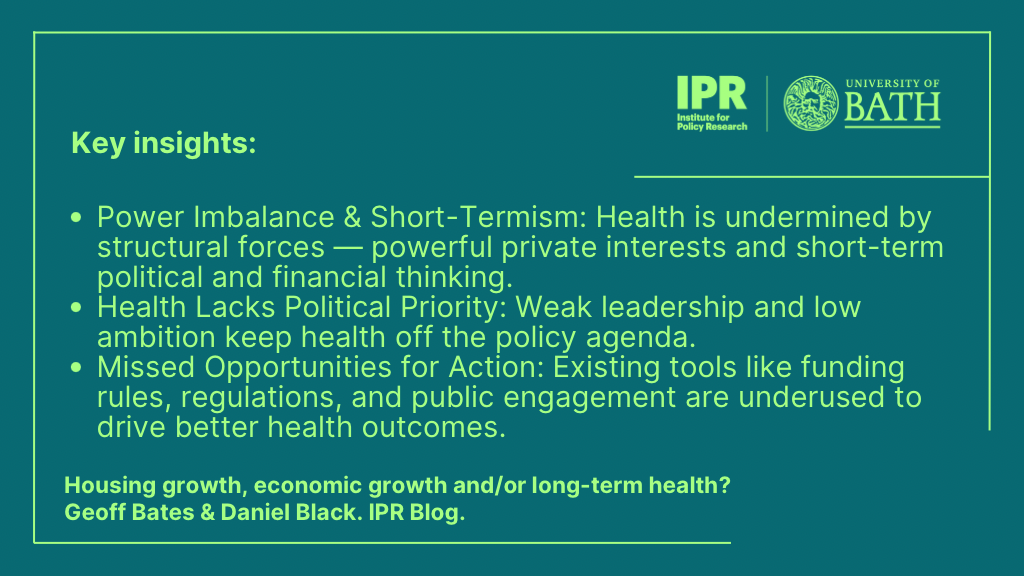The UK’s plan to build 1.5 million homes presents a rare opportunity to embed health in urban development. Yet new research reveals deep-rooted barriers across public and private sectors. Without urgent changes to decision-making and policy, this opportunity may be missed—worsening health outcomes instead of improving them. Here’s what needs to change, and why.
Dr Geoff Bates is a Research Fellow and Lecturer at the Institute for Policy Research, and Deputy Director of Studies on the Professional Doctorate in Policy Research & Practice. Daniel Black is an independent research director specialising in urban development, corporate decision-making and real-world impact, based currently at the University of Bristol Medical School where he is co-leading the TRUUD research programme.
The government’s ambitious manifesto pledge to build 1.5 million new homes received a boost in last week’s spending review, which included £39 billion for the provision of affordable housing. Along with anticipated plans for creating up to 12 new towns, these plans present an opportunity to provide the quality of housing and places to live that can improve and protect health. However, as our new research published this week in PLOS Sustainability and Transformation indicates, promoting health in this policy area remains highly challenging. A range of factors preventing healthier development need to be tackled, and these are located across public and private sectors, and from local to global levels.
An opportunity to tackle key drivers of poor health
Plans for new urban development at this scale offers ways of improving the long-term health of the population. For a country experiencing a public health crisis, this opportunity cannot be wasted: 80% of deaths are caused by preventable non-communicable diseases, life expectancy has stalled, the number of young people experiencing poor mental health is increasing greatly, and numbers of people out of work due to ill health continues to grow. We know that urban environments are key drivers of health and inequalities through factors such as quality of housing, levels of air and noise pollution, the local food environments, and accessibility and quality of green space. What better way therefore to promote long-term public health than to embed health firmly in the plans for new urban developments?
The government should not need any convincing in the importance of this, as it states within its own mission to Build an NHS Fit for the Future : “By addressing the main underlying drivers of ill-health and tackling persistent inequalities in health, we will put the NHS on a sustainable footing for the future”. However, there is no guarantee that new development will support good health. Indeed, there are plenty of reasons to fear the opposite, with so many new housing developments of poor quality and car dominated. To build on this opportunity, and that of wider opportunities such as the regeneration of existing areas and housing stock, some fundamental changes are needed amongst the decision-makers and processes that control urban development.
What needs to change?
Our research sought to identify where in the UK’s urban development systems interventions can be targeted to shape the development of healthier and more sustainable urban environments. Based on a series of activities to map and understand urban development decision-making in the first phase of the Tackling Root Causes Upstream of Unhealthy Urban Development (TRUUD) - including qualitative interviews, literature reviews, and supporting stakeholder workshops - we identified 50 ‘intervention areas’: specific problems preventing healthier development, each attached to a specific ‘problem holder’ or stakeholder group.
Within the 50 intervention areas identified, three main themes emerged:
- The first was the identification of a set of highly challenging global and structural problems: the commercial and political determinants of health, including the inherent short-termism in public and private sectors (political and financial), and the power of private sector federations and lobbying groups compared to underpowered local authorities.
- The second seemed, in theory at least, easier to achieve: the prioritisation of health in agenda setting, and the lack of ambition and leadership to promote health in policymaking.
- The third related to specific mechanisms where health is currently insufficiently included, but could be leveraged – particularly where supported by changes in agenda setting and leadership – such as funding criteria, regulatory requirements, local authority legal expertise, and effective public engagement.
What needs to happen next?
Our evidence strongly suggests that the current policy environment is creating substantial challenges for promoting long-term health outcomes. However, if health and the quality of new development is made a clear priority alongside quantity (of units), the government’s urban development agenda and health mission could also create major opportunities. The major structural challenges aside, there are many actions achievable in the short-term that should make a difference.
Examples of this delivered by the TRUUD team include: the supporting of urban development officials in government to systematically include health impacts in funding decisions and appraisals of new development and regeneration; the co-production of guidance for local authorities with the Town and Country Planning Association on embedding health in Local Plans; the embedding of better health data in city-region transport and spatial planning planning; the integration of quantifiable data in real estate investment decision-making; and the development of training videos and other resources to increase legal capacity for the effective use of health impact assessments.
These types of changes, implemented across multiple areas of decision-making, can help to shift the urban development system towards healthier outcomes. Further intervention is required of course, and work continues in this space. For example, the Local Health Global Profits consortium, including University of Bath researchers, is looking to understand and change how commercial factors influence public health, including through the urban planning system. It is by looking holistically at the problems preventing healthier development that we can identify ways to leverage better health. Systems-based, multi-level, interdisciplinary, and co-produced approaches can help to ensure that housing and planning agendas not only help deliver the new housing required, but the places to live that improve a whole range of outcomes including those relating to health, wellbeing, economy and employment.
All articles posted on this blog give the views of the author(s), and not the position of the IPR, nor of the University of Bath.
Respond





